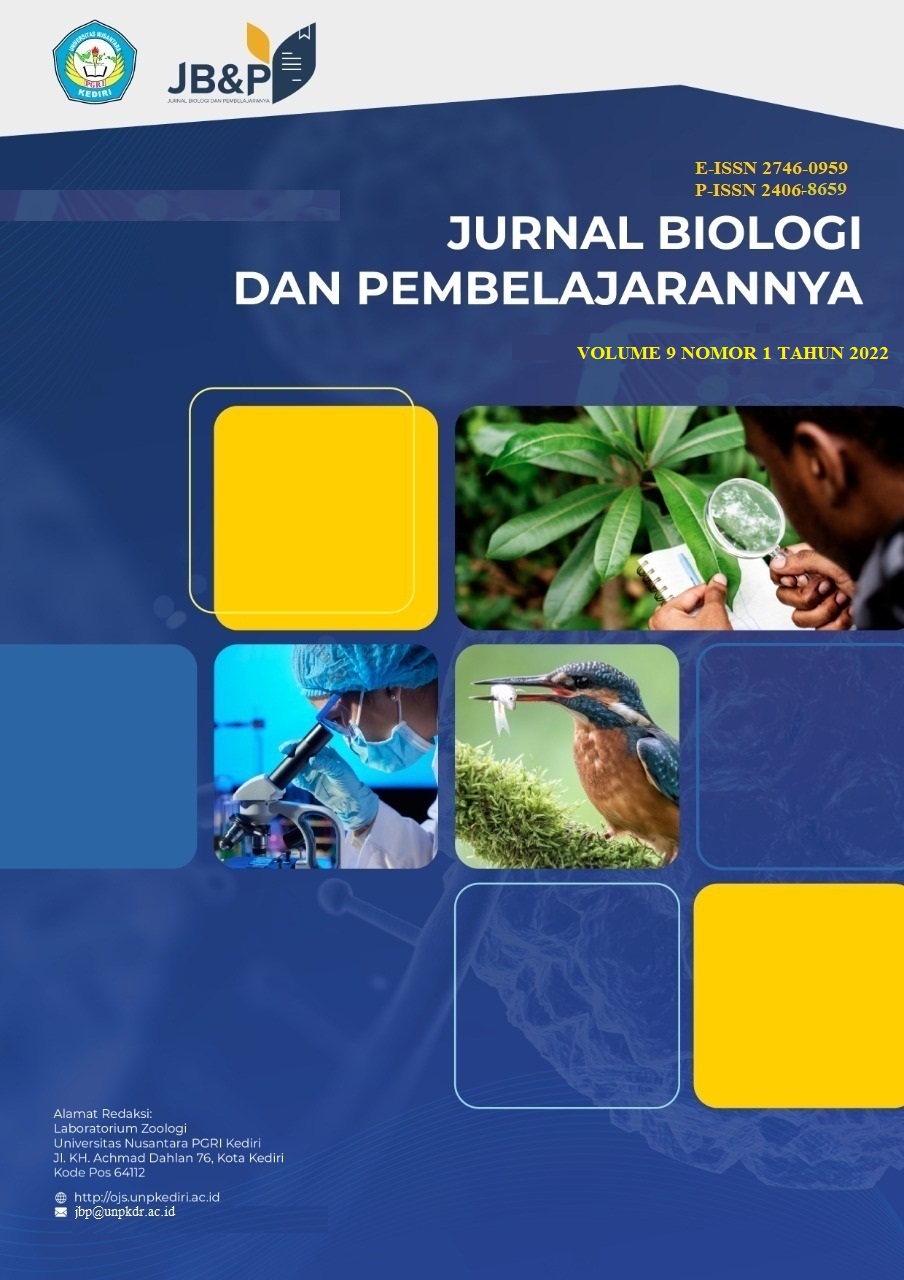Desain Pembelajaran Materi Produktivitas Menggunakan Pendekatan STEM Pada Mata Kuliah Ekologi
DOI:
https://doi.org/10.29407/jbp.v9i1.17526Keywords:
productivity, ecology, STEM, validation Study.Abstract
Productivity is one of the materials studied in ecology courses. As a result of the interview, many students still have difficulty in understanding this material and lecturers also have difficulty designing learning that connects context with the environment. Therefore, student learning activities need to be designed with a STEM approach. The research aims to produce a learning trajectory to help students on productivity materials using STEM approaches. The method used in this research is a design research type validation study consisting of three stages: preparing for the experiment, experiment in the classroom (pilot experiment & Teaching experiment), and restrospective analysis. The research subjects were 6 students and 3 lecturers. Research instruments in the form of interview sheets for students and lecturers and using student metacognitive questionnaires. The results of this study show that through a series of activities that have been done, learning using STEM can help students understand productivity materials and become a starting point in the learning process
References
Badan Standar Nasional Pendidikan. 2010. “Paradigma Pendidikan Nasional Abad XXI.” Paradigma Pendidikan Nasional Abad XXI: 1–59.
Fauziyah, Fauziyah, Zulkardi Zulkardi, and Ratu Ilma Indra Putri. 2016. “Desain Pembelajaran Materi Belah Ketupat Menggunakan Kain Jumputan Palembang Untuk Siswa Kelas VII.” Kreano, Jurnal Matematika Kreatif-Inovatif 7(1): 31–40.
Hariyadi, Bambang et al. 2014. “Perlukah Buku Ajar Ekologi?” Jurnal Biologi Edukasi 13(6): 64–70.
Ihda, S S R. 2019. “Studi Keanekaragaman Fitoplankton Di Telaga Desa Gampangsejati Kecamatan Laren Kabupaten Lamongan Sebagai Sumber Belajar ….” https://eprints.umm.ac.id/50344/.
Iii, F Stuart Chapin, Pamela A Matson, Harold A Mooney, and Harold A Mooney. Ecosystem Ecology.
Jauhariyyah1, Farah Robi’atul. 2017. “Science, Technology, Engineering and Mathematics Project Based Learning (STEM-PjBL) Pada Pembelajaran Sains Farah.” Pros. Seminar Pend. IPA Pascasarjana UM.
Jeklin, Andrew. 2016. “DESIGN RESEARCH PEMBELAJARAN PERBANDINGAN PADA AKTIVITAS PENGUKURAN.” 01(July): 1–23.
Juwita, Hariani, Ratu Ilma Indra Putri, and Somakim Somakim. 2015. “Peranan Buah Semangka Dalam Pembelajaran Volume Bola.” Jurnal Elemen 1(2): 130.
Lidinillah, Dindin Abdul Muiz. 2012. “Design Research Sebagai Model Penelitian Pendidikan.” Artikel Pada Kegiatan Pembekalan Penulisan Skripsi Mahasiswa S1 PGSD UPI Kampus Tasikmalaya (2): 40–41.
Lutfi, Ahmad. 2016. “Problem Posing Dan Berpikir Kreatif.” Prosiding Seminar Nasional Matematika dan Pendidikan Matematika (November): 88–98.
Nasriadi, Ahmad. 2016. “Berpikir Reflektif Siswa SMP Dalam Memecahkan Masalah Matematika Ditinjau Dari Perbedaan Gaya Kognitif.” Journal of Chemical Information and Modeling III(1): 15–26.
Plomp, T, and N Nieveen. 2013. “Educational Design Research Educational Design Research.” Netherlands Institute for Curriculum Development: SLO: 1–206. http://www.eric.ed.gov/ERICWebPortal/recordDetail?accno=EJ815766.
Rina, Safitri. 2020. “Pengembangan Lembar Kerja Peserta Didik ( LKPD ) Fisika Berbasis STEM ( Sains , Technology , Engineering , Mathematics ) Pada Materi Hukum Gravitasi Newton Dan Usaha Energi Kelas X SMA / MA.”.” Institut Agama Islam Negeri Batusangkar.
Sahin, Alpaslan. 2015. A Practice-Based Model of STEM Teaching: STEM Students on the Stage (SOS) A Practice-Based Model of STEM Teaching: Stem Students on the Stage (SOS)TM.
Sunaryo, Ade. 2017. “Produktivitas Primer Di Waduk Ir.H.Juanda Kabupaten Purwakarta Propinsi Jawa Barat.” Jurnal Penyuluhan Perikanan dan Kelautan 11(2): 110–20.
White, David W, and A Florida. 2014. “What Is STEM Education and Why Is It Important ?” (January).
Zabeta, Mewa, Yusuf Hartono, Ratu Ilma, and Indra Putri. 2015. “Desain Pembelajaran Materi Pecahan Menggunakan Pendekatan Pmridi Kelas Vii.” Jurnal Beta 8(1): 86–99. http://jurnalbeta.ac.id
Downloads
Published
Issue
Section
License
Authors who publish with this journal agree to the following terms:
- Copyright on any article is retained by the author(s).
- The author grants the journal, right of first publication with the work simultaneously licensed under a Creative Commons Attribution License that allows others to share the work with an acknowledgment of the work’s authorship and initial publication in this journal.
- Authors are able to enter into separate, additional contractual arrangements for the non-exclusive distribution of the journal’s published version of the work (e.g., post it to an institutional repository or publish it in a book), with an acknowledgment of its initial publication in this journal.
- Authors are permitted and encouraged to post their work online (e.g., in institutional repositories or on their website) prior to and during the submission process, as it can lead to productive exchanges, as well as earlier and greater citation of published work.
- The article and any associated published material is distributed under the Creative Commons Attribution-ShareAlike 4.0 International License













